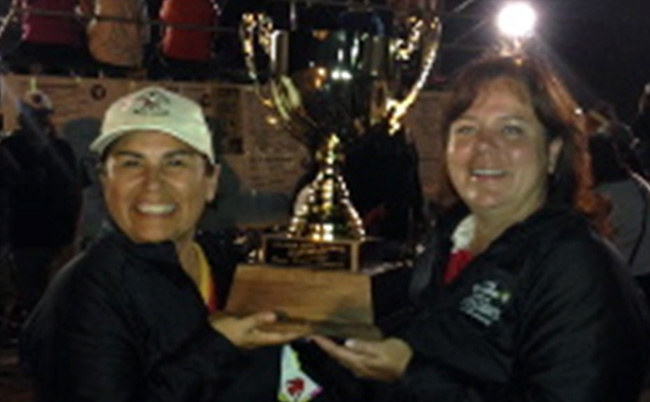A love for the game 60 years later


By Laurie Leclair
Social media was very busy this July chronicling The Big Scoop Supreme’s success in the Masters Women’s Division at the 2014 Canadian Native Fastball Championships held in Prince Albert, Saskatchewan.
Nipissing First Nation’s own Monique Sawyer and Jane Commanda were there to accept the trophy for their team – a memorial one assembled to honour Lori (Scoop) Johnson who passed away this spring.
Sawyer, who is the principal at Nbisiing Secondary School, finds that the sport not only keeps her in shape but allows her to focus on something other than her work. Commanda is a part-time college instructor at First Nations Technical Institute and loves the challenges and rewards that come with playing a “good game”.
Commanda, who helped her team the North American Native Sisters win a bronze medal at the World masters Games in Torino, Italy in 2013, also finds the mental and strategic focus to be as important as the physicality of the game. Both women are elite athletes but agree that they are also in it for the sheer love of the game and the camaraderie it brings.
60 years ago, this love of the game led a softball team from Batchewana to take the Trans-Canada highway east to Spanish River in order to play against the Garnier school team. Early in May 1954, Pitcher and captain Murray Sayers, Peter Cooper, Richard Nolan and his brother, catcher Frank Nolan, P. Neveau and first baseman Richard Agawa, together known as The Huskies, set out to play what Jane Commanda might call a “good game”. The write-up in the school newspaper, The Garnier Star, hinted at what must have been an exciting event:
“…Wm Sunday was a surprisingly clever pitcher whose curve ball, change of pace and control held the powerful Huskies to a few scattered hits…Batchewana was more in stride in the last three innings coming up from behind. R. Noland was on third with the tying run in the ninth inning with two men out. Alex Lamoureaux called for a pinch-hitter and Angus Roy’s bunt almost did the trick…”
Sadly, the Huskies lost 8 to 9 that day. But to hear the remembrances of Batchewana Elder Mr. Murray Sayers, it was all part of the game.
Six decades later, again in May, Mr. Sayers sat in his kitchen with his son Chief Dean Sayers and recalled what it was like to play for the Huskies during the late 1940’s and early 1950’s. Formed after the war, the club was active around the North Shore for at least a decade. Team Manager, Alexander Lamoureaux appointed Murray captain and together with a dozen or so young men they evolved from a pick-up gang of friends who would occasionally play a game of soft ball against their neighbours at Garden River, to an very successful hard ball league team. Games were usually on Sundays, and either Batchewana hosted, or together the team would climb into the back of Slim Goodfellow’s 5-ton open flat bed truck and travel to Goulais Bay, Agawa Bay, Thessalon, Spanish and other communities within their circuit.
Back then, like today, baseball drew fans of all ages – some people even crossing the border to attend. Lamoureux, who also ran the village hall, set up dances as fundraisers – allowing the team to have money for travel and buy pop, ice, equipment and uniforms. There wasn’t much money to be made in post-war baseball; the beauty of the game was enough.
“We played for the love and the fun of it, ” recalled Murray Sayers.
When asked what his favorite pitch was, Sayers could not decide. He liked knuckle balls and fast pitches, but his main strategic weapon was his range of pitching styles. Although his elbow would trouble him later, he was able to avoid the type of shoulder injuries common to pitchers by varying his throw. Sayers recalled that this technique, together with a warm sweater and a bottle of Absorbine, Jr. once got him through a most difficult double header –two nine inning games against Garden River and Goulais Bay.
The Huskies disbanded in 1955, and after that date would play the odd exhibition games against teams in Wawa and Bay Mills.


